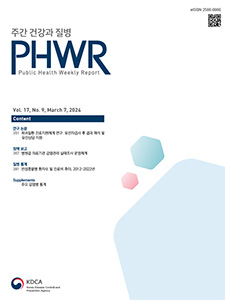Current Issue
Vol.17 No.9, March 07, 2024
-
Original Articles 2024-03-07
 0
0
 525
525
 238
238
Developmental of a Support System for the Genetic Diagnosis and Counseling of Rare Disease
Gu-Hwan Kim, In-Hee Choi, Beom Hee Lee, Jiwon M. Lee
Public Health Weekly Report 2024; 17(9): 351-366 https://doi.org/10.56786/PHWR.2024.17.9.1AbstractThere are difficulties in diagnosis and counseling after genetic testing, due to the increase in the rate of diagnostic results arising from the development of genetic testing techniques and the discovery of mutations with unclear pathogenicity derived from next-generation sequencing. By presenting examples of additional support provided for the interpretation of results after genetic testing and subsequent genetic counseling support, we attempted to present a system that seeks to resolve difficulties that may generally be experienced in the post-genetic testing process. Fifteen cases of interpretation support were provided through the post-genetic-testing result-interpretation support project under the support of the Korea Disease Control and Prevention Agency, and effective genetic counseling support was provided accordingly. Diagnostic support through the interpretation of results after genetic testing was aimed at resolving the diagnostic odyssey of rare genetic diseases. Moreover, support for appropriate diagnoses can reduce the social and economic burdens. We propose a national-level management system for medical genetics team services covering treatment, testing, and counseling.
-
Policy Notes 2024-03-07
 1
1
 547
547
 267
267
Hospital-level Medical Institution Infection Control Status Survey Operation System
Namyi Kim, Jeongsuk Song, Sook-Kyung Park, Insun Hwang, Kwangyul Son, Hyewon Jeon
Public Health Weekly Report 2024; 17(9): 367-380 https://doi.org/10.56786/PHWR.2024.17.9.2 Abstract
AbstractThe Korea Disease Control and Prevention Agency established and implemented a standardized survey system to prepare basic data for formulating and evaluating policies to prevent healthcare-associated infections, that identified the status of infection control based on the results of statistical analysis. We developed a survey standardizing questionnaire to gather information on the prevention and control of infection in healthcare facilities and an online survey system. A field survey system was utilized to verify the reliability of the survey. The online survey was conducted by respondents filling out the questionnaire themselves (computer-assisted self interviewing). Thereafter, some of the respondents from the online survey were randomly selected for a field survey where professional investigators visited the hospitals, and the limitations of the online survey were complemented. In the first survey on acute-care hospital infection control survey in 2021, 1,197 out of 1,767 hospitals (67.7%) participated in the online survey, and the field survey was conducted in 125 hospitals. In the survey on long-term care hospital infection control survey in 2022, 1,270 out of 1,365 hospitals (93.0%) participated in the online survey, and the field survey was conducted in 140 hospitals. The concordance (Gwet’s AC1) between online survey responses and field survey results ranged from 0.52 to 0.92. The survey system was established initially to identify the status of infection control in healthcare facilities after the revision of the Infectious Disease Prevention Act made it mandatory to investigate infection control. The Korea Disease Control and Prevention Agency will establish and regularize this survey as a national survey system by improving on the limitations found in the first hospital-level healthcare institution survey.
-
QuickStats 2024-03-07
 0
0
 390
390
 221
221
Trends in the Number of Chronic Kidney Disease Patients and Medical Expenses, During 2012–2022
Public Health Weekly Report 2024; 17(9): 381-382 https://doi.org/10.56786/PHWR.2024.17.9.3

pp. 1~2097
Most Keyword
?
What is Most Keyword?
- It is the most frequently used keyword in articles in this journal for the past two years.
Most Read
-
Waterborne and Foodborne Disease Outbreaks in the Republic of Korea, 2023
Myung-Jae Hwang, So Yeon Park, Hyungjun Kim, Se Jeong Yang, Sungchan Yang, Jin Seon Yang
Public Health Weekly Report 2025;18: 17-32 https://doi.org/10.56786/PHWR.2025.18.1.2 -
Implementation Plan for the Coronavirus Disease 2019 Vaccination for the 2024–2025 Season: Recommendations of the 6th Expert Committee on Immunization Practices
Hyewook Hwang, Wookeon Lee, Seohyeon Ahn, Young-Sook Choi, Seunghyun Lewis Kwon, Dongwoo Lee, Eun Hwa Choi, SokGoo Lee
Public Health Weekly Report 2025;18: 90-102 https://doi.org/10.56786/PHWR.2025.18.2.3
Editorial Office
+82-43-719-7569





 Full Text
Full Text Cite
Cite


